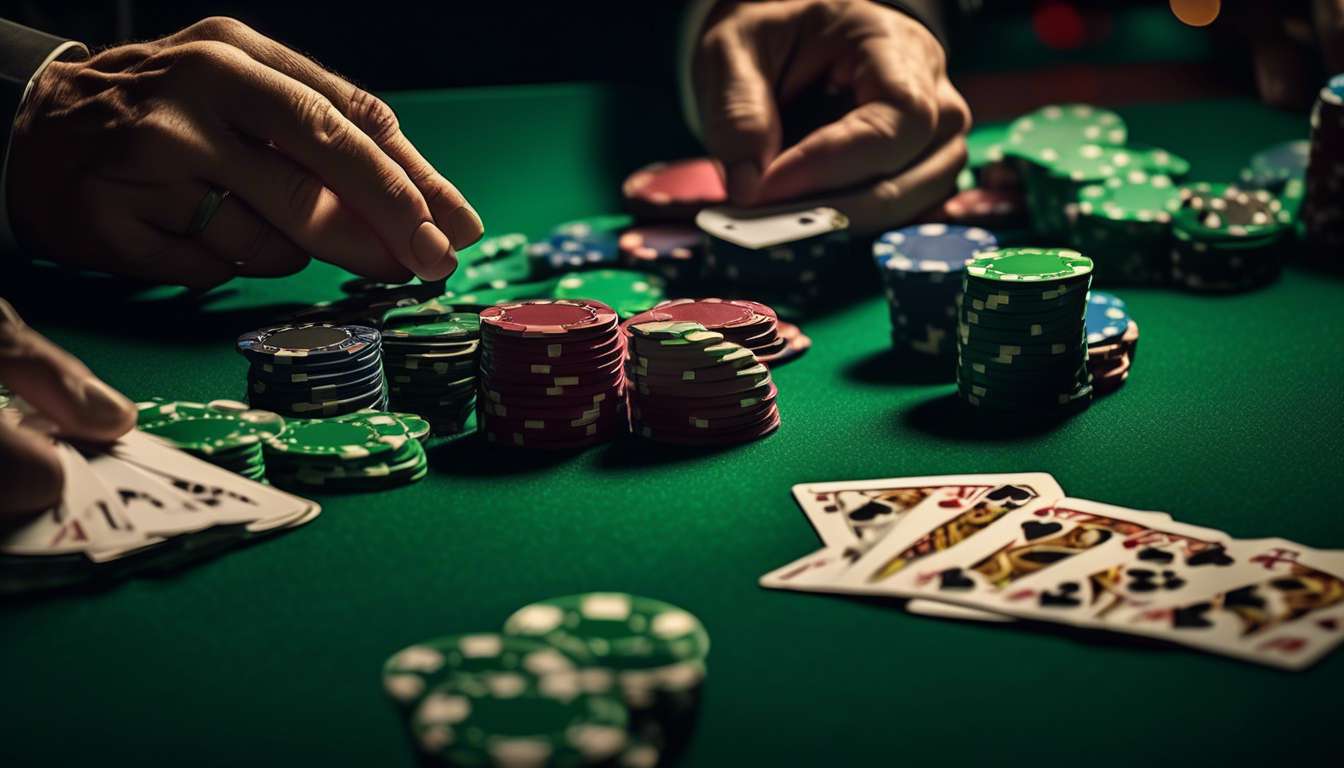When we step into the vibrant world of a casino, the allure of blackjack often calls out to us with its promise of excitement and the tantalizing possibility of victory. As we gather around the table, cards in hand, we understand that mastering the basics is crucial if we wish to play with confidence and skill.
In this article, we’ll embark on a journey to demystify the game of blackjack, exploring the fundamental rules and strategies that form the backbone of this timeless card game. Our goal is to equip ourselves with the knowledge needed to make informed decisions, maximizing our chances of success while minimizing the house edge.
Key Concepts:
-
Card Values:
- Number cards (2 through 10) are worth their face value.
- Face cards (Jack, Queen, King) are worth 10 points.
- Aces can be worth either 1 or 11 points, depending on which value benefits the hand more.
-
The Dealer’s Role:
- The dealer must follow strict rules, typically hitting until reaching a total of 17 or higher.
- Understanding the dealer’s constraints can help players make strategic decisions.
-
Strategic Choices:
- Players have several options during their turn, including hitting, standing, doubling down, or splitting pairs.
- Each decision can significantly impact the outcome of the hand.
Objective: By understanding the significance of card values, the dealer’s role, and the strategic choices available, we can transform our approach from mere chance to calculated play.
Let’s delve into the essentials, ensuring each hand we play is grounded in strategy and insight.
Understanding Card Values
In blackjack, each card has a specific value that is essential for making strategic decisions.
Card Values:
-
Number Cards (2-10): Each card holds its face value. For example, a seven is worth seven points, and a nine equals nine points.
-
Face Cards (Kings, Queens, Jacks): These cards are each worth ten points, adding a bit of royal flair to our hand.
-
Ace: This is the wild card, offering flexibility by being worth either one or eleven points, depending on what best suits your hand.
Understanding these values brings us closer to making strategic decisions. When we gather around the table, this foundational knowledge ensures we’re ready to make the best possible choices, enhancing our shared experience and camaraderie.
Let’s master the game together, feeling confident and included, like we’re part of a club that speaks its own language.
Dealer’s Gameplay Rules
In blackjack, the dealer follows a strict set of rules to ensure a fair and consistent game. Understanding these rules enhances our experience at the table by making us feel part of the game.
Dealer’s Rules:
- The dealer does not make decisions like players. Instead, they adhere to house rules.
- They are required to hit until they reach a hand value of 17 or higher.
- If their hand totals 16 or less, they must take another card.
- Once the dealer hits 17, they must stand, regardless of whether it’s a hard or soft 17.
Benefits for Players:
- This consistency is crucial for players as it removes any guesswork about the dealer’s next move.
- Knowing how the dealer plays helps us understand the dynamics of the game.
- It fosters a sense of community as we all engage with the same predictable structure.
By mastering these basics of how to play blackjack, we share a common bond in the game.
Player’s Strategic Options
In blackjack, our strategic options as players include hitting, standing, doubling down, splitting pairs, and surrendering, each offering unique advantages depending on the situation.
Hitting
- When we hit, we’re asking for another card, hoping to improve our hand.
- It’s a move we often make when our total is low.
Standing
- Standing means we’re satisfied with our hand and don’t want any more cards.
- It signals that we’re ready to see how the dealer plays out their hand.
Doubling Down
- Doubling down is exciting—it’s when we double our bet after seeing our initial two cards.
- We commit to hit just once more.
- It’s a bold move, often used when we’re confident in our hand’s potential.
Splitting Pairs
- Splitting pairs allows us to turn a pair into two separate hands.
- This increases our chances to win.
Surrendering
- Surrendering lets us fold our hand early.
- We reclaim half our bet.
Understanding these moves is crucial for effectively playing blackjack and belonging in this strategic community.
Importance of Hand Total
Understanding the hand total is crucial because it dictates our strategic choices in blackjack. Each card’s value contributes to a sum that guides our next move.
The hand total acts as our compass, helping us decide whether to:
- Hit
- Stand
- Surrender
By mastering this core element, we feel a sense of belonging in the blackjack community, making informed decisions alongside fellow players.
In the game of blackjack, our goal is to reach as close to 21 as possible without exceeding it. A hand total of 21, also known as a "blackjack," is the ultimate achievement.
The challenge lies in knowing when to:
- Push for a higher total
- Hold back
By understanding our hand total, we can confidently anticipate outcomes and adapt our strategy accordingly, enhancing our overall experience at the table.
Doubling Down Strategy
Doubling down is a bold move that can double our potential winnings by increasing our bet after the initial deal. However, it requires careful consideration of:
- Our hand total
- The dealer’s upcard
By doubling our bet, we commit to receiving just one additional card, so timing and intuition become our best allies.
When to Consider Doubling Down:
-
Hand Totals of 9, 10, or 11:
- Doubling down becomes particularly enticing when our hand totals 9, 10, or 11.
-
Dealer’s Weaker Upcard (3 through 6):
- In these scenarios, we seize the opportunity to capitalize on potential dealer busts.
It’s about reading the table, feeling the rhythm of the game, and making informed decisions that include our community’s shared wisdom.
Together, we can embrace the thrill of doubling down, strengthening both our skill and confidence in how to play blackjack effectively.
Let’s make each move count on our journey to mastering the game.
Splitting Pairs Strategy
Splitting pairs can significantly enhance our chances by allowing us to turn a single hand into two separate hands, potentially doubling our opportunity to win. When learning how to play blackjack, understanding when to split pairs is crucial. We become part of a community of savvy players who make strategic decisions, so let’s delve into this tactic.
When to Split Pairs:
- We should always split aces and eights.
- Splitting aces gives us a fresh start with two powerful cards.
- Splitting eights helps us escape a weak hand totaling 16.
With our newfound knowledge, we’re better equipped to face the dealer confidently.
When Not to Split:
- Avoid splitting tens or face cards because a total of 20 is already strong. By keeping them together, we maintain a higher chance of winning.
- Also, avoid splitting fives—doubling down is usually the better option here.
By mastering the splitting pairs strategy, we strengthen our understanding of how to play blackjack and connect with others who share our passion.
Insurance and Side Bets
In the world of blackjack, insurance and side bets offer intriguing opportunities to enhance the gaming experience, though they come with their own risks and rewards. Understanding these elements can make players feel more connected to the game and fellow players.
Insurance is an option when the dealer’s upcard is an Ace. Players can choose to place an additional bet, hoping the dealer’s hand is a blackjack. It’s like a safety net, but remember, it can be a risky play, as it often favors the house.
Side bets, on the other hand, add an extra layer of excitement. These can include:
- Bets on pairs
- The possibility of getting a 21 with the first two cards
While side bets may boost adrenaline and camaraderie, they also come with higher house edges.
As we explore how to play blackjack, it’s important to weigh the thrill against the strategy to maintain a balance between fun and smart play.
Mastering Basic Blackjack Strategy
Mastering basic blackjack strategy involves understanding when to hit, stand, double down, or split to optimize our chances of winning. As a community of blackjack enthusiasts, we’re all striving to make smarter decisions at the table.
To do this, we need to familiarize ourselves with a strategy chart, which guides us on the best moves based on our hand and the dealer’s upcard. It’s about making informed choices that align with the probabilities of the game.
Key Strategies:
-
Hitting:
- Necessary when our hand totals are low.
-
Standing:
- Wise when we’re closer to 21.
-
Doubling Down:
- Can maximize winnings when the odds are in our favor.
-
Splitting Pairs:
- Can turn a single hand into two potential winners.
By applying these strategies consistently, we can feel confident and connected with fellow players who share our goal of mastering this classic game.
What is the history and origin of the game of Blackjack?
Blackjack, a popular card game, has a rich history that dates back centuries. It originated in Europe and evolved over time into the game we know today.
The game’s name, Blackjack, comes from an early version where players received a special payout for a hand that included:
- The Jack of Spades
- The Jack of Clubs
This simple yet intriguing game has stood the test of time and continues to captivate players worldwide.
How does Blackjack differ from other popular casino card games like Poker or Baccarat?
Blackjack differs from other popular casino card games like Poker or Baccarat in its simplicity and focus on beating the dealer’s hand without exceeding 21.
We, as a community of players, appreciate the fast-paced nature of Blackjack and the strategic decision-making involved in every round.
Comparison with Other Card Games:
-
Poker:
- Involves more complex rules.
- Requires understanding various hand rankings and betting strategies.
-
Baccarat:
- Relies heavily on luck.
- Players have limited decision-making during the game.
Why Blackjack Stands Out:
- Offers a balance of skill and chance.
- Keeps players engaged with opportunities for strategic choices.
- Encourages returning play due to its dynamic nature.
What are some common myths and misconceptions about playing Blackjack?
There are several myths and misconceptions about playing Blackjack that can deter people from enjoying the game. Some common ones include:
- The belief that card counting guarantees a win every time.
- The misconception that the dealer always has the upper hand.
- The idea that you have to be a math genius to play Blackjack successfully.
These myths can be easily debunked with a bit of practice and understanding. By learning the basic strategies and rules of the game, players can improve their skills and enjoy Blackjack without being misled by these misconceptions.
Conclusion
Now that you’ve grasped the fundamentals of playing blackjack, you’re ready to hit the tables with confidence.
By understanding card values, dealer rules, and strategic options, you can enhance your gameplay. Remember the importance of hand totals, and consider strategies like:
- Doubling down
- Splitting pairs
Be cautious of insurance and side bets, and aim to master basic blackjack strategy to give yourself the best chance of success at the casino.
Good luck at the tables!

